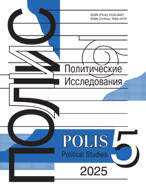On the way to a multipolar world:
metaphors in the BRICS summits declarations
Koshkarova N.N.,
South Ural State University, Chelyabinsk, Russia, studiumjuvenis@mail.ru
elibrary_id: 355000 | ORCID: 0000-0001-8861-0353 | RESEARCHER_ID: S-4540-2017
Solopova О.A.,
South Ural State University, Chelyabinsk, Russia, o-solopova@bk.ru
elibrary_id: 512712 | ORCID: 0000-0003-4170-7267 | RESEARCHER_ID: R-8524-2017
Chudinov А.P.,
Ural State Pedagogical University, Ekaterinburg, Russia, ap_chudinov@mail.ru
elibrary_id: 198143 | ORCID: 0000-0001-5436-5273 |
Article received: 2024.11.19 21:51. Accepted: 2025.02.19 21:51

DOI: 10.17976/jpps/2025.03.08
EDN: KEEQQB
Koshkarova N.N., Solopova О.A., Chudinov А.P. On the way to a multipolar world: metaphors in the BRICS summits declarations. – Polis. Political Studies. 2025. No. 3. https://doi.org/10.17976/jpps/2025.03.08. EDN: KEEQQB (In Russ.)
The research is financially supported by Russian Science Foundation № 24-18-00049, https://rscf.ru/project/24-18-00049/.
The main focus of the research is the use of the “path” metaphor in the BRICS grouping political discourse. The significance of the research is due to extralinguistic and linguistic factors, among them are the growing role of BRICS on the world stage and the function of the archetypal “path” metaphor in the political discourse structure. The source of the data was sixteen BRICS summit declarations in English (2009–2024). The objective of the study was to investigate the characteristics of the “path” metaphor in the BRICS grouping political discourse. Corpus, definitional, component, contextual, metaphor modeling, cognitive and discourse methods were used to analyze frequency lists, collocations, sets of words covering the conceptual domain, their metaphorical senses and factors, influencing the latter. The findings suggest that the “path” source domain is highly structured, it contains several key components: ways and surroundings; route; purpose, causes and nature; motivating or hindering factors; vehicles; co-travelers, team; journey results analysis. The authors argue that the “path” metaphor sets a direction, serves as a roadmap for outlining short-term and long-term plans, produces images of progressive movement, integrated actions in achieving common goals and overcoming challenges. In the BRICS summit declarations, the “path” metaphor helps to shape BRICS’ collective identity, by strengthening solidarity and cooperation between the countries, modeling positive images of the grouping, shaping the future that inspires and motivates the audience.
References
Abdel-Raheem, А. (2014). The journey metaphor and moral political cognition. Pragmatics and Cognition, 22(3), 373-401. https://doi.org/10.1075/pc.22.3.06abd
Ahrens, K., & Wing-Shan Chan, I. (2015). Changes on the use of journey metaphors in American presidential speeches. The 13th International Cognitive Linguistics Conference (ICLC-13).
Bas, K. (2021). The role of metaphor in Turkish politics: PATH and BUILDING metaphors. In M. Brdar, G. Milić, D. Vidaković Erdeljić, & R. Brdar-Szabó (Eds.), Figurative Thought and Language in the Human Universe (pp. 73-92). Cambridge Scholars Publishing.
Caruso, A. (2014). A roadmap to peace. Journey metaphors in political speeches on the Middle East peace process. Lingue e Linguaggi, 11, 77-92. https://doi.org/10.1285/i22390359v11p77
Charteris-Black J. (2006). Politicians and rhetoric. The persuasive power of metaphor. Basingstoke: Palgrave MacMillan.
Cibulskiene, J. (2012). The development of the journey metaphor in political discourse: time-specific changes. Metaphor and the Social World, 2(2), 131-153. https://doi.org/10.1075/msw.2.2.01cib
Coll-Florit, M., Roca, S.C. (2022). Enemies or obstacles? Metaphors of war and journey in mental health discourse. Metaphor and the Social World, 12(2), 181-203. https://doi.org/10.1075/msw.21035.col
Forceville, C. (2016). The FORCE and BALANCE schemas in JOURNEY metaphor animations. In Multimodality and performance (pp. 8-22). Newcastle-upon-Tyne: Cambridge Scholars.
Gyula, A.D., & Furkó, P. (2015). The journey metaphor in mediatized political discourse. Acta Universitatis Sapientiae, Philologica, 7(2), 7-20. https://doi.org/10.1515/ausp-2015-0043
Johnson M. (1987). The body in the mind: the bodily basis of meaning, imagination, and reason. Chicago: University of Chicago Press.
Lakoff, G., & Johnson, M. (1980). Metaphors we live by. Chicago: University of Chicago Press.
Lakoff, G., & Johnson, M. (1999). Philosophy in the flesh: the embodied mind and its challenge to western thought. New York: Basic Books.
Moragas-Fernández, C.M., Montagut, M., & Capdevila, A. (2018). The process en route: the metaphor of the journey as the dominant narrative for the political discourse in Catalonia. Critical Discourse Studies, 15(5), 517-539. https://doi.org/1-2310.1080/17405904.2018.1468787
Otieno, R.F. (2019). The role of the “Path” and the “Container” image schemas in political discourse in Kenya. English Language Teaching and Linguistics Studies, 1(2), 123-140. https://doi.org/10.22158/eltls.v1n2p123
Pavlović, T.V. (2019). The Role of path metaphors in conceptualising life in English and Serbian: a corpusbased analysis. Masaryk University Press.
Ritchie, L.D. (2008). X is a journey: embodied simulation in metaphor interpretation. Metaphor and Symbol, 23, 174-199. https://doi.org/10.1080/10926480802223085
Silaški, N., & Đurović, T. (2019). The journey metaphor in Brexit-related political cartoons. Discourse Content & Media, 31(2), 100318 https://doi.org/10.1016/j.dcm.2019.100318
Wang, F., & Chengcan, D. (2024). Exploring self-construction of the American international image: a conceptual metaphor perspective. Advances in Social Behavior Research, 7(1), 70-74. https://doi.org/10.54254/2753-7102/7/2024052
Zibin, A., & Solopova, O. A. (2024). Metaphors across languages, cultures, and discourses: a research agenda. Russian Journal of Linguistics, 28(1), 7-32. https://doi.org/10.22363/2687-0088-37837
Aleshina, E.Yu. (2016). Genre specificity of political discourse. Liberal Arts in Russia, 5(3), 293-301. (In Russ.) https://doi.org/10.15643/libartrus-2016.3.4
Arhimandrit Rafail (Karelin). (1999). Put’ hristianina. Propovedi [The way of a Christian. Sermons]. Moscow: Moskovskoe podvor’e Svjato-Troickoj Sergievoj Lavry. (In Russ.)
Aristotel. (2005). Evdemova jetika [Eudemian ethics]. Moscow: IF RAN. (In Russ.)
Bobrova, Ye.A. (2013). Metaphorical concept as way of categorizing the outside world by the example of the metaphor of travel. Izvestiya of Irkutsk State Economics Academy (Baikal State University of Economics and Law), 3, 28-32. (In Russ.)
Budaev, Ye.V., Solopova, O.A., Zaripov, R.I., & Boyko, A.V. (2021). Metaforicheskij obraz budushhego Rossii v zarubezhnyh SMI [Metaphorical image of the future of Russia in foreign media]. Saint Petersburg: Naukoemkie tehnologii. (In Russ.)
Chang, Jui-Cheng. (2023). Cognitive study of path metaphor and military metaphor in political discourse (based on the material of Tsai Ing-wen’s address on the occasion of Double Tenth Day in 2022 and its translation in Russian and English). Critique and Semiotics, 1, 85-104. (In Russ.) https://doi.org/10.25205/2307-1753-2023-1-85-104
Chudinov, A.P. (2001). Rossija v metaforicheskom zerkale: kognitivnoe issledovanie politicheskoj metafory (1991-2000) [Russia in a metaphorical mirror: a cognitive study of political metaphor (1991-2000)]. Ekaterinburg: USPU. (In Russ.)
Chudinov, A.P. (2012). Discursive characteristics of political communication. Political Linguistics, 2, 53-59. (In Russ.)
Dao i telos v smyslovom izmerenii kul’tur vostochnogo i zapadnogo tipa [Dao and Telos in the semantic dimension of Eastern and Western cultures]. (2011). Vladivostok: Far Eastern Federal University Publishing House. (In Russ.)
Geraklit. (1969). Fragmenty [Fragments]. In Antologija mirovoj filosofii (v 4 tomah) [Antologiya mirovoy filosofii (v 4 tomakh)]. T. 1. Ch. 1. Moscow: Mysl’. (In Russ.)
Grigor’yeva, T.G. (1979.) Yaponskaya khudozhestvennaya traditsiya [Japanese artistic tradition]. Moscow: Main editorial office of oriental literature, Nauka publishing house.s (In Russ.)
Heidegger, M. (1991). Razgovor na proselochnoj doroge [Conversation on a country road]. Moscow: Vysshaja shkola. (In Russ.)
Camus, A. (1990). Buntujushhij chelovek. Filosofija. Politika. Iskusstvo [Rebellious Man. Philosophy. Politics. Art]. Moscow: Politizdat. (In Russ.)
Kapustin, B.G. (2024). On the metaphor “revolutions are the locomotives of history”. Polis. Political Studies, 3, 50-73. (In Russ.) https://doi.org/10.17976/jpps/2024.03.05
Koshkarova, N.N. (2020). Public apology: yesterday, today, tomorrow. Speech Genres, 3, 214-221. (In Russ.) http://dx.doi.org/10.18500/2311-0740-2020-3-27-214-221
Li, M., & Solopova, O.A. (2021). Metaphorical modelling of the image of China in modern political discourse. Political Linguistics, 2, 98-105. (In Russ.) https://doi.org/10.26170/1999-2629_2021_02_09
Maltseva, E.A. (2022). Road as an object of conceptual reflexivity. Ideas and Ideals, 14(3–2), 385-402. (In Russ.) http://dx.doi.org/10.17212/2075-0862-2022-14.3.2-385-402
Matveeva, N.V. (2023). The linguocultural specificity of the basic metaphor “way/road” (based on the material of speeches of Chinese president Xi Jinping). Political Linguistics, 2, 160-169. (In Russ.)
Mihaylina, T.I. (2022). Discourse characteristics of BRICS declarations. Modern Science: Actual Problems of Theory and Practice. Series of “Humanities”, 2-2, 181-185. (In Russ.)
Pimenova, M.V. (2017). Konceptual’naja metafora “Zhizn’ – put’/doroga” v russkom i anglijskom jazykah [Conceptual metaphor “Life is a path/road” in Russian and English]. In Mir v jazyke i kul’ture [Peace in Language and Culture] (pp. 29-48). Saint Petersburg: Saint Petersburg State University of Economics. (In Russ.)
Rukin, A.V. (2020). The concept of a human person in existential tradition. BSU bulletin. Philosophy, 1, 66-72. (In Russ.) https://doi.org/72.10.18101/1994-0866-2020-1-66-72
Sartre, J.-P. (2022). Les Chemins De La Liberte. (Russ. ed: Sartre, J.-P. Dorogi svobody. Moscow: AST). Sheigal, Ye.I. (2004). Semiotika politicheskogo diskursa [Semiotics of political discourse]. Moscow: Gnozis. (In Russ.)
Shchepanskaya, T.B. (2003). Kul’tura dorogi v russkoj miforitual’noi tradicii XIX-XX vv. [The culture of the road in the Russian mythological and ritual tradition of the 19th-20th centuries]. Moscow: Indrik. (In Russ.)
Solopova, O.A. (2016). “The different” that matters: Russia and America (linguistic political analysis based on the material of American political discourse of the XIXth century). Political Linguistics, 1, 126-135. (In Russ.)
Steksova, T.I. (2016). Declarativity in political discourse. Political Linguistics, 5, 56-62. (In Russ.)
See also:
Krestinina Ye.S.,
Image of «the Other» in the structure of modern identity of russian society. – Polis. Political Studies. 2011. No4
Zeveleva O.I.,
Migration policy and collective identity: the case of the russian-germans in Germany. – Polis. Political Studies. 2014. No6
Kubyshkina Ye.V.,
US political discourse under the presidency of G. Bush Jr.: evolution of metaphors. – Polis. Political Studies. 2012. No1
Nezhdanov D.V., Rusakova O.F.,
«Political market» as system-forming metaphor of modern political-science discourse. – Polis. Political Studies. 2011. No4
Vendina O.I., Kolosov V.A., Popov F.A., Sebentzov A.B.,
Ukraine in the political crisis: the image of Russia as catalyst of contradictions. – Polis. Political Studies. 2014. No5




.jpg)






 print
print
.jpg)
.jpg)